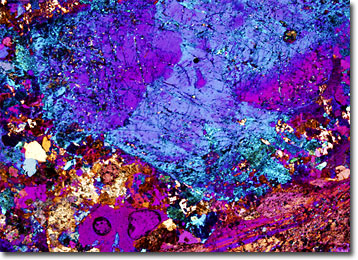Polarized Light Microscopy Digital Image Gallery
Monzonite
Monzonite is an intrusive igneous rock that received its name from Mount Monzoni in northeast Italy, which is the location where the substance was first described. Though not particularly rare, this type of rock usually occurs in small masses closely associated with other rocks, such as gabbros and pyroxenites.

Similar to anorthosite and syenite rocks in composition, monzonite primarily consists of the minerals classified as feldspars. One of the ways that the rock may be differentiated from similar ones, however, is that it typically contains plagioclase and orthoclase, or potash, feldspars in approximately equal amounts. Yet, other substances, such as biotite, hornblende, and ortho-pyroxene, may also be present in monzonite. Furthermore, the occasional occurrence of nepheline, olivine, and quartz in the material has resulted in the designation of several monzonite subtypes.
Quartz monzonite, which is present in many mountain belts, is extremely resistant to erosion. In fact, the hardness and durability of the substance has been centrally involved in the formation of many natural wonders, such as the awe-inspiring Curecanti Needle in the Black Canyon of Colorado. This towering spire was created over thousands of years, as the rushing waters of the Gunnison River and its tributaries slowly weathered away the softer surrounding metamorphic rock, leaving only the resilient quartz monzonite monolith in its path.
